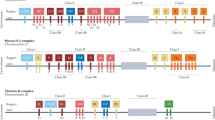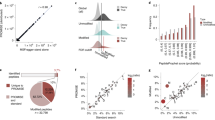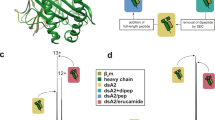Abstract
Specific immune responses are critically dependent on protein degradation products in the form of peptides. These peptides are presented by major histocompatibility complexes (MHCs), and recognition of MHC–peptide complexes by the immune system determines successful pathogen elimination, transplant rejection, autoimmunity or death. Here we review the immune response from the peptide's perspective and discuss the fate of peptides in cells before presentation by MHC complexes. We then discuss how peptides are altered post-translationally to yield immune responses and how peptides can be engineered to achieve strong immune responses following vaccination. Although peptides are simple from a chemical perspective, they are complex in their immunological consequences.
This is a preview of subscription content, access via your institution
Access options
Subscribe to this journal
Receive 12 print issues and online access
$259.00 per year
only $21.58 per issue
Buy this article
- Purchase on Springer Link
- Instant access to full article PDF
Prices may be subject to local taxes which are calculated during checkout



Similar content being viewed by others
References
Reinherz, E.L. et al. The crystal structure of a T cell receptor in complex with peptide and MHC class II. Science 286, 1913–1921 (1999).
Garcia, K.C. et al. An ab T cell receptor structure at 2.5 Å and its orientation in the TCR–MHC complex. Science 274, 209–219 (1996). The first MHC–TCR co-crystal showing how the TCR recognizes the combination of MHC class I and peptide.
Lo, W.L. & Allen, P.M. Self-peptides in TCR repertoire selection and peripheral T cell function. Curr. Top. Microbiol. Immunol. (2013).
Neefjes, J., Jongsma, M.L., Paul, P. & Bakke, O. Towards a systems understanding of MHC class I and MHC class II antigen presentation. Nat. Rev. Immunol. 11, 823–836 (2011).
Cho, J.H. & Gregersen, P.K. Genomics and the multifactorial nature of human autoimmune disease. N. Engl. J. Med. 365, 1612–1623 (2011).
Yewdell, J.W., Reits, E. & Neefjes, J. Making sense of mass destruction: quantitating MHC class I antigen presentation. Nat. Rev. Immunol. 3, 952–961 (2003).
Murata, S., Takahama, Y. & Tanaka, K. Thymoproteasome: probable role in generating positively selecting peptides. Curr. Opin. Immunol. 20, 192–196 (2008).
Nitta, T., Murata, S., Ueno, T., Tanaka, K. & Takahama, Y. Thymic microenvironments for T-cell repertoire formation. Adv. Immunol. 99, 59–94 (2008).
Kloetzel, P.M. & Ossendorp, F. Proteasome and peptidase function in MHC-class-I-mediated antigen presentation. Curr. Opin. Immunol. 16, 76–81 (2004).
Cascio, P., Hilton, C., Kisselev, A.F., Rock, K.L. & Goldberg, A.L. 26S proteasomes and immunoproteasomes produce mainly N-extended versions of an antigenic peptide. EMBO J. 20, 2357–2366 (2001).
Reits, E. et al. A major role for TPPII in trimming proteasomal degradation products for MHC class I antigen presentation. Immunity 20, 495–506 (2004).
Reits, E. et al. Peptide diffusion, protection, and degradation in nuclear and cytoplasmic compartments before antigen presentation by MHC class I. Immunity 18, 97–108 (2003). This study shows the fate of peptides in living cells using 'single-cell biochemistry'. It also shows that peptides live for few seconds in living cells unless they are N-terminally protected from aminopeptidases.
Neefjes, J.J., Momburg, F. & Hammerling, G.J. Selective and ATP-dependent translocation of peptides by the MHC-encoded transporter. Science 261, 769–771 (1993).
Momburg, F., Roelse, J., Hammerling, G.J. & Neefjes, J.J. Peptide size selection by the major histocompatibility complex-encoded peptide transporter. J. Exp. Med. 179, 1613–1623 (1994).
Chang, S.C., Momburg, F., Bhutani, N. & Goldberg, A.L. The ER aminopeptidase, ERAP1, trims precursors to lengths of MHC class I peptides by a “molecular ruler” mechanism. Proc. Natl. Acad. Sci. USA 102, 17107–17112 (2005).
Ortmann, B. et al. A critical role for tapasin in the assembly and function of multimeric MHC class I–TAP complexes. Science 277, 1306–1309 (1997).
Roelse, J., Gromme, M., Momburg, F., Hammerling, G. & Neefjes, J. Trimming of TAP-translocated peptides in the endoplasmic reticulum and in the cytosol during recycling. J. Exp. Med. 180, 1591–1597 (1994).
Romagnoli, P. & Germain, R.N. The CLIP region of invariant chain plays a critical role in regulating major histocompatibility complex class II folding, transport, and peptide occupancy. J. Exp. Med. 180, 1107–1113 (1994).
Ghosh, P., Amaya, M., Mellins, E. & Wiley, D.C. The structure of an intermediate in class II MHC maturation: CLIP bound to HLA-DR3. Nature 378, 457–462 (1995).
Pos, W. et al. Crystal structure of the HLA-DM–HLA-DR1 complex defines mechanisms for rapid peptide selection. Cell 151, 1557–1568 (2012). A crystal structure of a designed HLA-DR1 dimer with HLA-DM revealing how a chaperone manipulates the HLA-DR1 structure to allow peptide binding.
Denzin, L.K. & Cresswell, P. HLA-DM induces CLIP dissociation from MHC class II ab dimers and facilitates peptide loading. Cell 82, 155–165 (1995).
Roche, P.A. & Cresswell, P. Proteolysis of the class II-associated invariant chain generates a peptide binding site in intracellular HLA-DR molecules. Proc. Natl. Acad. Sci. USA. 1991. 88: 3150–3154. J. Immunol. 187, 1076–1080 (2011).
Stanfield, R.L. & Wilson, I.A. Protein-peptide interactions. Curr. Opin. Struct. Biol. 5, 103–113 (1995).
Spee, P. & Neefjes, J. TAP-translocated peptides specifically bind proteins in the endoplasmic reticulum, including gp96, protein disulfide isomerase and calreticulin. Eur. J. Immunol. 27, 2441–2449 (1997).
Lammert, E., Stevanovic, S., Brunner, J., Rammensee, H.G. & Schild, H. Protein disulfide isomerase is the dominant acceptor for peptides translocated into the endoplasmic reticulum. Eur. J. Immunol. 27, 1685–1690 (1997).
Matsumura, M., Fremont, D.H., Peterson, P.A. & Wilson, I.A. Emerging principles for the recognition of peptide antigens by MHC class I molecules. Science 257, 927–934 (1992).
Speir, J.A., Stevens, J., Joly, E., Butcher, G.W. & Wilson, I.A. Two different, highly exposed, bulged structures for an unusually long peptide bound to rat MHC class I RT1-Aa. Immunity 14, 81–92 (2001).
Stern, L.J. et al. Crystal structure of the human class II MHC protein HLA-DR1 complexed with an influenza virus peptide. Nature 368, 215–221 (1994).
Mohan, J.F. & Unanue, E.R. A novel pathway of presentation by class II-MHC molecules involving peptides or denatured proteins important in autoimmunity. Mol. Immunol. 55, 166–168 (2013).
Falk, K., Rotzschke, O., Stevanovic, S., Jung, G. & Rammensee, H.G. Allele-specific motifs revealed by sequencing of self-peptides eluted from MHC molecules. Nature 351, 290–296 (1991). Breakthrough paper describing conserved amino acids within the peptide set associated to a particular MHC class I molecule. These so-called anchor residues appeared to fill pockets in the MHC class I (and class II) structure.
Madden, D.R., Garboczi, D.N. & Wiley, D.C. The antigenic identity of peptide-MHC complexes: a comparison of the conformations of five viral peptides presented by HLA-A2. Cell 75, 693–708 (1993).
Hanada, K., Yewdell, J.W. & Yang, J.C. Immune recognition of a human renal cancer antigen through post-translational protein splicing. Nature 427, 252–256 (2004). This study shows the concept of peptide splicing yielding new peptides for MHC class I antigen presentation. These peptides are not genetically encoded but are the result of proteasomal degradation and proteasomal ligation into a new combination to result post-translationally in a new peptide sequence.
Vigneron, N. et al. An antigenic peptide produced by peptide splicing in the proteasome. Science 304, 587–590 (2004). This study shows the concept of peptide splicing yielding new peptides for MHC class I antigen presentation. These peptides are not genetically encoded but are the result of proteasomal degradation and proteasomal ligation into a new combination to result post-translationally in a new peptide sequence.
Warren, E.H. et al. An antigen produced by splicing of noncontiguous peptides in the reverse order. Science 313, 1444–1447 (2006).
Grommé, M. et al. The rational design of TAP inhibitors using peptide substrate modifications and peptidomimetics. Eur. J. Immunol. 27, 898–904 (1997).
Andersen, M.H. et al. Phosphorylated peptides can be transported by TAP molecules, presented by class I MHC molecules, and recognized by phosphopeptide-specific CTL. J. Immunol. 163, 3812–3818 (1999).
Haurum, J.S. et al. Presentation of cytosolic glycosylated peptides by human class I major histocompatibility complex molecules in vivo. J. Exp. Med. 190, 145–150 (1999).
Altrich-VanLith, M.L. et al. Processing of a class I–restricted epitope from tyrosinase requires peptide N-glycanase and the cooperative action of endoplasmic reticulum aminopeptidase 1 and cytosolic proteases. J. Immunol. 177, 5440–5450 (2006).
Wang, Y. & Dai, S. Structural basis of metal hypersensitivity. Immunol. Res. 55, 83–90 (2013).
Illing, P.T. et al. Immune self-reactivity triggered by drug-modified HLA-peptide repertoire. Nature 486, 554–558 (2012). This is the first study showing how particular drugs can bind in the MHC class I peptide-binding groove to alter the conformation of peptides and thus the immune response.
Romagnoli, P., Labhardt, A.M. & Sinigaglia, F. Selective interaction of Ni with an MHC-bound peptide. EMBO J. 10, 1303–1306 (1991).
Falta, M.T. et al. Identification of beryllium-dependent peptides recognized by CD4+ T cells in chronic beryllium disease. J. Exp. Med. 1403–1418. (2013).
Sollid, L.M., Qiao, S.W., Anderson, R.P., Gianfrani, C. & Koning, F. Nomenclature and listing of celiac disease relevant gluten T-cell epitopes restricted by HLA-DQ molecules. Immunogenetics 64, 455–460 (2012).
Wucherpfennig, K.W. & Hafler, D.A. A review of T-cell receptors in multiple sclerosis: clonal expansion and persistence of human T-cells specific for an immunodominant myelin basic protein peptide. Ann. NY Acad. Sci. 756, 241–258 (1995).
Mallone, R., Brezar, V. & Boitard, C. T cell recognition of autoantigens in human type 1 diabetes: clinical perspectives. Clin. Dev. Immunol. 2011, 513210 (2011).
Thomson, G. et al. Genetic heterogeneity, modes of inheritance, and risk estimates for a joint study of Caucasians with insulin-dependent diabetes mellitus. Am. J. Hum. Genet. 43, 799–816 (1988).
Stritesky, G.L., Jameson, S.C. & Hogquist, K.A. Selection of self-reactive T cells in the thymus. Annu. Rev. Immunol. 30, 95–114 (2012).
Lyons, D. S. et al. A TCR binds to antagonist ligands with lower affinities and faster dissociation rates than to agonists. Immunity 5, 53–61 (1996).
Larché, M. & Wraith, D.C. Peptide-based therapeutic vaccines for allergic and autoimmune diseases. Nat. Med. 11, S69–S76 (2005).
Kenter, G.G. et al. Vaccination against HPV-16 oncoproteins for vulvar intraepithelial neoplasia. N. Engl. J. Med. 361, 1838–1847 (2009). This proof-of-principle study may be a basis for new vaccination strategies.
Paulis, L.E., Mandal, S., Kreutz, M. & Figdor, C.G. Dendritic cell-based nanovaccines for cancer immunotherapy. Curr. Opin. Immunol. 25, 389–395 (2013).
Kast, W.M. et al. Protection against lethal Sendai virus infection by in vivo priming of virus-specific cytotoxic T lymphocytes with a free synthetic peptide. Proc. Natl. Acad. Sci. USA 88, 2283–2287 (1991).
DeNardo, S.J. et al. Effect of molecular size of pegylated peptide on the pharmacokinetics and tumor targeting in lymphoma-bearing mice. Clin. Cancer Res. 9, 3854S–3864S (2003).
Bontrop, R.E. Comparative genetics of MHC polymorphisms in different primate species: duplications and deletions. Hum. Immunol. 67, 388–397 (2006).
Strominger, J.L. & Wiley, D.C. The 1995 Albert Lasker Medical Research Award. The class I and class II proteins of the human major histocompatibility complex. J. Am. Med. Assoc. 274, 1074–1076 (1995).
Pircher, H. et al. Viral escape by selection of cytotoxic T cell–resistant virus variants in vivo. Nature 346, 629–633 (1990).
Jorritsma, A., Schumacher, T.N. & Haanen, J.B. Immunotherapeutic strategies: the melanoma example. Immunotherapy 1, 679–690 (2009).
Khan, S. et al. Chirality of TLR-2 ligand Pam3CysSK4 in fully synthetic peptide conjugates critically influences the induction of specific CD8+ T-cells. Mol. Immunol. 46, 1084–1091 (2009). An example of designed modification of synthetic peptides with TLR ligands to further improve vaccination. These strategies may be coupled to long peptides for successful vaccines.
Khan, S. et al. Distinct uptake mechanisms but similar intracellular processing of two different Toll-like receptor ligand-peptide conjugates in dendritic cells. J. Biol. Chem. 282, 21145–21159 (2007).
Neefjes, J.J., Smit, L., Gehrmann, M. & Ploegh, H.L. The fate of the three subunits of major histocompatibility complex class I molecules. Eur. J. Immunol. 22, 1609–1614 (1992).
Engels, B. et al. Relapse or eradication of cancer is predicted by peptide-major histocompatibility complex affinity. Cancer Cell 23, 516–526 (2013).
Valeur, E. & Bradley, M. Amide bond formation: beyond the myth of coupling reagents. Chem. Soc. Rev. 38, 606–631 (2009).
El-Faham, A. & Albericio, F. Peptide coupling reagents, more than a letter soup. Chem. Rev. 111, 6557–6602 (2011).
Kammertoens, T. & Blankenstein, T. It's the peptide-MHC affinity, stupid. Cancer Cell 23, 429–431 (2013).
Townsend, A.R. et al. The epitopes of influenza nucleoprotein recognized by cytotoxic T lymphocytes can be defined with short synthetic peptides. Cell 44, 959–968 (1986). This is the first paper showing that peptides rather than proteins from a virus were detected by cytotoxic T cells. This paper was first received with skepticism in the field.
Fremont, D.H., Matsumura, M., Stura, E.A., Peterson, P.A. & Wilson, I.A. Crystal structures of two viral peptides in complex with murine MHC class I H-2Kb. Science 257, 919–927 (1992).
Andersson, I.E., Dzhambazov, B., Holmdahl, R., Linusson, A. & Kihlberg, J. Probing molecular interactions within class II MHC Aq/glycopeptide/T-cell receptor complexes associated with collagen-induced arthritis. J. Med. Chem. 50, 5627–5643 (2007).
Reinelt, S. et al. β-amino acid scan of a class I major histocompatibility complex-restricted alloreactive T-cell epitope. J. Biol. Chem. 276, 24525–24530 (2001).
Acknowledgements
This work was supported by a Horizon grant from the Netherlands Genomics Initiative to H.O., a European Research Council advanced grant to J.N. and a Netherlands Organisation for Scientific Research–Chemische Wetenschappen (NWO-CW) TOP grant jointly to H.O. and J.N. We thank P. Celie and M. Garstka for help with figures.
Author information
Authors and Affiliations
Corresponding authors
Ethics declarations
Competing interests
The authors declare no competing financial interests.
Rights and permissions
About this article
Cite this article
Neefjes, J., Ovaa, H. A peptide's perspective on antigen presentation to the immune system. Nat Chem Biol 9, 769–775 (2013). https://doi.org/10.1038/nchembio.1391
Received:
Accepted:
Published:
Issue Date:
DOI: https://doi.org/10.1038/nchembio.1391
This article is cited by
-
Effects of C-Terminal-Ethyl-Esterification in a Snake-Venom-Based Peptide Against the Neurotoxicity of Acrolein in PC12 Cells
International Journal of Peptide Research and Therapeutics (2023)
-
A transformer-based model to predict peptide–HLA class I binding and optimize mutated peptides for vaccine design
Nature Machine Intelligence (2022)
-
Immunoproteasome expression is associated with better prognosis and response to checkpoint therapies in melanoma
Nature Communications (2020)
-
A transplantable tumor model allowing investigation of NY-BR-1-specific T cell responses in HLA-DRB1*0401 transgenic mice
BMC Cancer (2019)
-
Epstein–Barr virus strain heterogeneity impairs human T-cell immunity
Cancer Immunology, Immunotherapy (2018)



